

Untitled. Choice page. Tiananmen Square Massacre. China is Surveilling and Threatening Uighurs in the U.S. China’s Museums Are Twisting the Truth to Chase TV Ratings. Since last December, CCTV, China’s state-run television network, has aired a number of television series involving the country’s museums.

“National Treasure,” for example, intersperses features on Chinese historical artifacts with celebrity re-enactments of the period when they were excavated. “If National Treasures Could Talk” is an out-and-out documentary about the country’s most fabled artifacts. And “Win at the Museum” is a history quiz show aimed at children. None of these shows carry particularly high ratings — “National Treasure,” for instance, corners a mere 3 percent of the market when it airs — but they are hitting the airwaves with greater frequency.
They’ve also inspired discussion on online platforms such as microblogging site Weibo and Quora-like site Zhihu, not to mention in so-called bullet screens — a form of in-video comment found on China’s various streaming platforms. Seeing Red: China’s Communist Revolution Captured on Camera. This is the third article in a series on “Old Photos,” a Chinese-language publication that collects images of the country’s modern history.
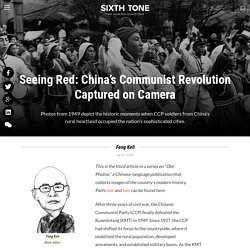
Parts one and two can be found here. The Foreign Missionaries Who First Turned a Lens on China. This is the second article in a series on “Old Photos,” a Chinese-language publication that collects images of the country’s modern history.
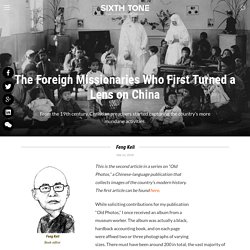
The first article can be found here. While soliciting contributions for my publication “Old Photos,” I once received an album from a museum worker. The album was actually a black, hardback accounting book, and on each page were affixed two or three photographs of varying sizes. There must have been around 200 in total, the vast majority of which were taken in and around Yantai, a port city in eastern China’s Shandong province, in the early 20th century. A note the size of my palm was stuck to the other side of the hardback cover, explaining that the photos were confiscated from a foreign missionary working in the area when the Communist Party reunified China in 1949.
China’s official history books tend to focus primarily on grand narratives. At the time, Chinese people were wary of foreign missionaries. War, Hardship, and Separation: Portraits of a Changing China. The art of photography was introduced into China in the latter half of the 19th century.
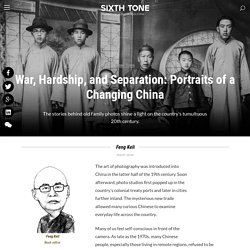
Soon afterward, photo studios first popped up in the country’s colonial treaty ports and later in cities further inland. The mysterious new trade allowed many curious Chinese to examine everyday life across the country. How Long-Unpublished Press Photos Bring Life to Chinese History. This is the fourth article in a series on “Old Photos,” a Chinese-language publication that collects images of the country’s modern history.
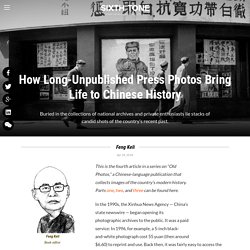
Parts one, two, and three can be found here. In the 1990s, the Xinhua News Agency — China’s state newswire — began opening its photographic archives to the public. It was a paid service: In 1996, for example, a 5-inch black-and-white photograph cost 55 yuan (then around $6.60) to reprint and use. Back then, it was fairly easy to access the archives, as long as you had a letter of introduction from your employer. I visited the Xinhua archives in Beijing several times, sending staff scurrying off to the storeroom to retrieve albums for me to peruse. Two minutes to midnight: did the US miss its chance to stop North Korea’s nuclear programme? Pyongyang International is one of the world’s quieter airports.

The country’s chronic isolation means that there are not many places to fly, and few foreigners keen on visiting. At least until a new terminal was built in 2012, many of the flights on the departure boards were just for show, giving the appearance of connection with the outside world. They never actually took off. Against this melancholy backdrop, one day in late May 1999, something quite extraordinary happened. This Japanese Scroll Was Re-Printed a Million Times—700 Years Before Gutenberg - Atlas Obscura.
Empress Shōtoku occupied the Japanese throne twice.
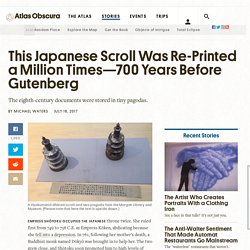
She ruled first from 749 to 758 C.E. as Empress Kōken, abdicating because she fell into a depression. In 761, following her mother’s death, a Buddhist monk named Dōkyō was brought in to help her. The two grew close, and Shōtoku soon promoted him to high levels of government far out of step with his nominal political experience. Her cousin Fujiwara no Nakamaro questioned her judgment, and a battle ensued that ended in the cousin’s death and Shōtoku’s renewed claim to the throne. With Dōkyō at her side, she ruled as Empress Shōtoku from 764 to 770. So Empress Shōtoku did something that would reverberate throughout world history: she ordered the printing of one million dhāranī texts. China Cooperative. The Writings of Chuang Tzu. Ancient China. Ancient China - Ancient Civilizations. East Asia also has dry areas.
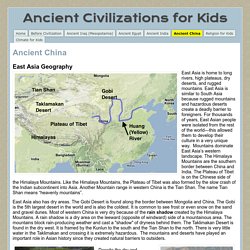
The Art of Asia. BBC The Story of India - Episode 1 - Beginnings. Ancient Chinese Civilization 1 click. Chinese Historical Accounts the Forbidden City, the home of the Chinese emperors until the last dynasty was overthrown in the 20th century Chinese history, until the twentieth century, was written mostly by members of the ruling scholar-official class and was meant to provide the ruler with precedents to guide or justify his policies.
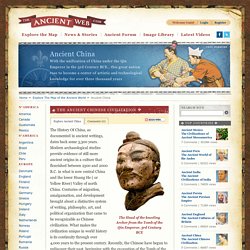
These accounts focused on dynastic politics and colorful court histories and included developments among the commoners only as backdrops. Timelines of Asia TOC: India, China, Japan. East India Company - Once world’s most powerful corporation 2 clicks. It was the most powerful multinational corporation the world had ever seen.

Founded in 1600, the English East India Company’s power stretched across the globe from Cape Horn to China. The company was established for trading, with a royal charter by Queen Elizabeth I granting it a monopoly over business with Asia. Imagine a company with the influence of Google or Amazon, granted a state-sanctioned monopoly and the right to levy taxes abroad But the Company’s influence went further. It owned the ports of Singapore and Penang and played a major role in developing cities including Mumbai, Kolkata and Chennai.
Biographical Dictionary of Chinese Women: The Qing Period, 1644-1911 - Lily Xiao Hong Lee, A. D. Stefanowska. The Essence of Buddhas Teaching. The Four Noble Truths: 1. All things and experiences are marked by suffering/ disharmony/ frustration (dukkha). 2. The arising of suffering/ disharmony/ frustration comes from desire/ craving/ clinging. 3. 4. Asia was settled in multiple waves of migration, DNA study suggests. An international team of researchers studying DNA patterns from modern and archaic humans has uncovered new clues about the movement and intermixing of populations more than 40,000 years ago in Asia. Using state-of-the-art genome analysis methods, scientists from Harvard Medical School and the Max Planck Institute for Evolutionary Anthropology in Leipzig, Germany, have found that Denisovans -- a recently identified group of archaic humans whose DNA was extracted last year from a finger bone excavated in Siberia -- contributed DNA not just to present-day New Guineans, but also to aboriginal Australian and Philippine populations.
The study demonstrates that contrary to the findings of the largest previous genetic studies, modern humans settled Asia in more than one migration. According to David Reich, a professor of genetics at Harvard Medical School, "Denisova DNA is like a medical imaging dye that traces a person's blood vessels. China History: Chronology, Dynasty Qin Han Tang Song Yuan Ming Qing. China, one of the countries that can boast of an ancient civilization, has a long and mysterious history - almost 5,000 years of it! Like most other great civilizations of the world, China can trace her culture back to a blend of small original tribes which have expanded till they became the great country we have today.
It is recorded that Yuanmou man is the oldest hominoid in China and the oldest dynasty is Xia Dynasty. From the long history of China, there emerge many eminent people that have contributed a lot to the development of the whole country and to the enrichment of her history. Among them, there are emperors like Li Shimin (emperor Taizong of the Tang), philosophers like Confucius, great patriotic poets like Qu Yuan and so on.
Chinese society has progressed through five major stages - Primitive Society, Slave Society, Feudal Society, Semi-feudal and Semi-colonial Society, and Socialist Society. Chinese History Chronology. The Real Reason America Used Nuclear Weapons Against Japan. It Was Not To End the War Or Save Lives. Like all Americans, I was taught that the U.S. dropped nuclear bombs on Hiroshima and Nagasaki in order to end WWII and save both American and Japanese lives. But most of the top American military officials at the time said otherwise. The U.S. Strategic Bombing Survey group, assigned by President Truman to study the air attacks on Japan, produced a report in July of 1946 that concluded (52-56): Based on a detailed investigation of all the facts and supported by the testimony of the surviving Japanese leaders involved, it is the Survey’s opinion that certainly prior to 31 December 1945 and in all probability prior to 1 November 1945, Japan would have surrendered even if the atomic bombs had not been dropped, even if Russia had not entered the war, and even if no invasion had been planned or contemplated.
General (and later president) Dwight Eisenhower – then Supreme Commander of all Allied Forces, and the officer who created most of America’s WWII military plans for Europe and Japan – said: China: Surviving the Camps by Zha Jianying. By now, it has been nearly forty years since the Cultural Revolution officially ended, yet in China, considering the magnitude and significance of the event, it has remained a poorly examined, under-documented subject. Official archives are off-limits.
(2) What the Ancients Knew - The East - The Chinese. Chine History Timeline.